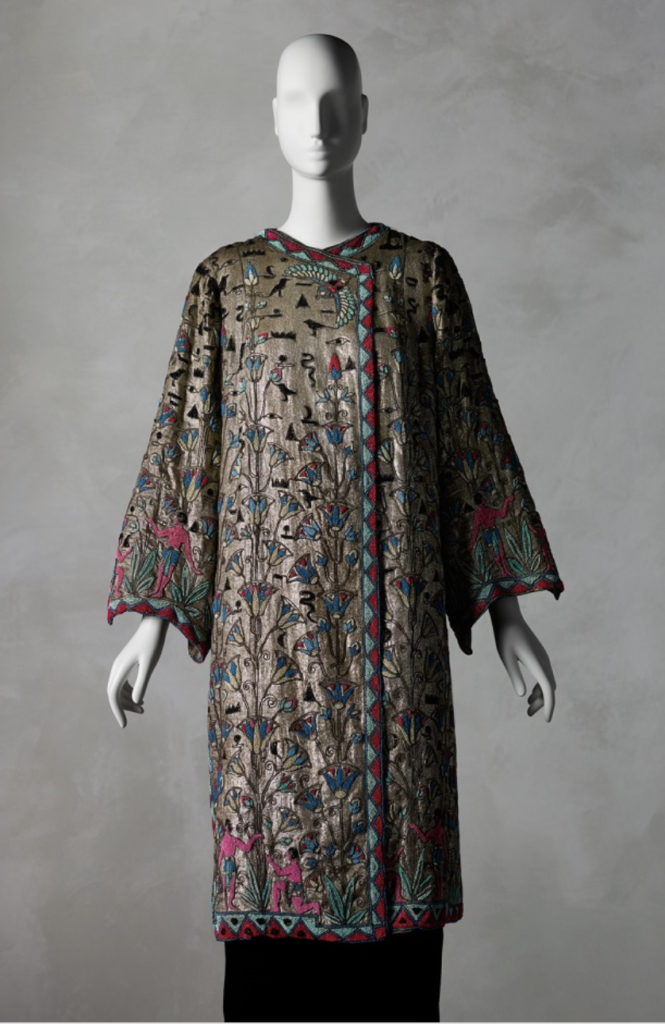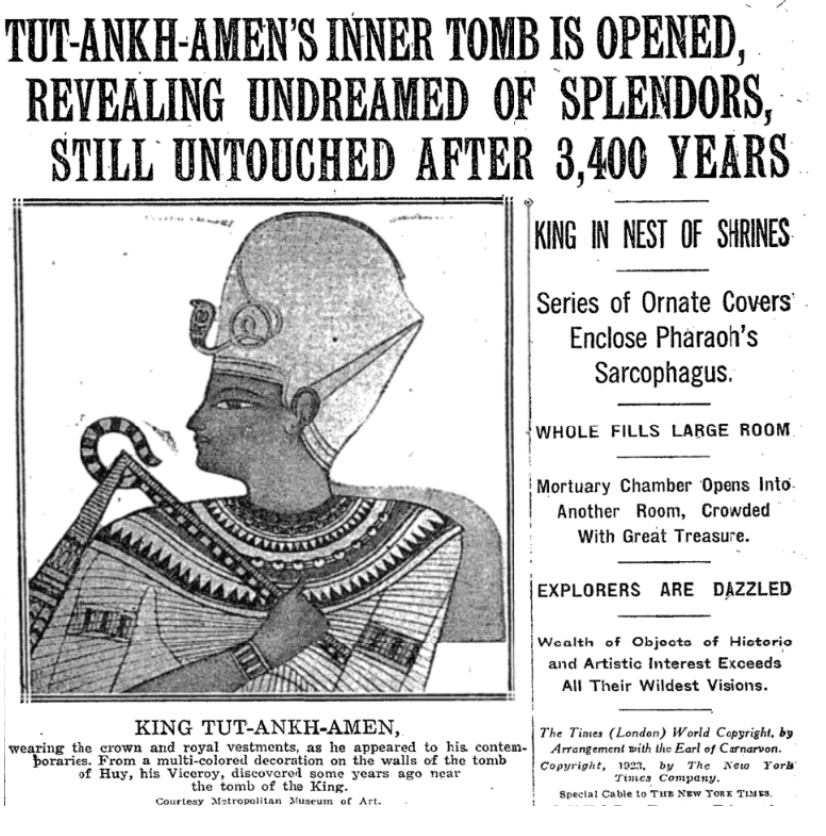Exploration in the 1920s heavily influenced it to be the groundbreaking period that it was. It was a period of indulging in lavish leisure activities and adhering to the newest fashion making headlines during the decade. Brilliant new discoveries were being made as well as brand new technological advances; one of the most striking discoveries of the century being the exhumation of King Tutankhamun’s tomb in Luxor, Egypt. This exhumation sparked a huge societal and historical revolution, specifically within the United States. People became fascinated with the lifestyles of the Egyptians and thus ensued the “Tut-mania” of the 1920s.
King Tutankhamun
King Tutankhamun’s tomb was exhumed on February 16, 1923, by archaeologist Howard Carter along with a group of historians and important figures in the world at the time. The discovery of this tomb shocked the world as it opened up a time portal to the past treasures of Ancient Egypt. Upon entering the tomb, they were greeted with golden figures and deep blues of lapis lazuli. Decorative inscriptions and insignia left to protect Tutankhamun in his journey to the afterlife were captivating to those who viewed it and left society engrossed in the lifestyle of royalty in Ancient Egypt. King Tut was immortalized in a scene of wealth and gold, and was celebritized thousands of years later for exactly that scene.
When photographs of the findings started to become published to the public, the craze of Egyptian treasures and mystery grew. While there was an overall interest in Ancient Egypt for years before the discovery of the tomb, it reached new highs and left a heavier influence of fashion, makeup, furniture, and fabrics; adding to the new-founded art deco aesthetic. American society sought to replicate the beauty of Egyptian culture within their own lives, and so the United States saw a surge in King Tut-related advertisements, music, books, and movies. He was sensationalized by the media and saw the relics in his tombs as alluring artwork.

King Tutankhamun’s Influence on Society
King Tutankhamun’s rise in popularity was fueled by the American desire to have similar Egyptian treasures of their own. Some parallels can be drawn between the two eras of history; both have been remembered for their lavish lifestyles, unique fashion, and technological advances. As seen in the image above, Egyptian influence on fashion was a key part in the fashion of the 1920s. Short shift dresses often worn by women and men in Ancient Egypt can be seen as similar to the newer, shorter dresses donned by a younger society of women wanting to break free from the modest norm. Statement jewelry of gold and precious jewels were a staple in both eras of history and signified wealth and social status.
Aside from societal revolution, the public exhumation of the tomb brought about a new surge of interest in archaeology and the history found through it. It amazed the public that such an old civilization could have such beautiful and long-lasting treasures. The public became obsessed with these findings, which further fueled the craze for Egyptian history.

The image taken from a New York Times article published on February 16, 1923 further proves the amazement that the public had for King Tutankhamun. Language such as, “dazzled,” “undreamed of splendors,” and “king in nest of shrines,” shows how this discovery took the world by storm. It was truly made out to be luxurious turn of events for historians and the public. The article continues to fawn over the tremendous discoveries inside of the Pharaoh’s final resting place; vivid vocabulary describes the picture of the discovery to be other-worldly and beyond beautiful. It was no wonder the world became so infatuated with King Tutankhamun, as the media was glamorizing the artifacts he was buried with. King Tut was left with his physical wealth at his side, something humans have long been obsessed with; ways to showcase and immortalize their wealth. Tut-mania in the 1920s continued this trend, specifically with the Egyptians in mind, by publishing media and fashion based around it.
Relation to the 1920s
Tut-mania and its influence on the decade of the 1920s proves to be very prominent as time goes on. Fashion trends of this time period were heavily influenced by the findings in King Tutankhamun’s tomb as well as other groundbreaking discoveries in Egyptology. Dresses of the 1920s were decorated in beadwork and embroidery akin to Egyptian art and motifs. Makeup looks of the decade had an emphasis on black kohl eyeliner around the eyes, which was very similar to the style the Egyptians had used thousands of years ago. Society in the United States, especially, drew a lot of inspiration from the findings in King Tutankhamun’s tomb. As mentioned previously, it held significant contribution to the Art Deco style that was frequently used in this time period and leading up into the 1930s. Use of color in furniture in art show a very strong resemblance to the colors often used in Ancient Egyptian art.
Aside from fashion and art, King Tutankhamun served as a cultural icon during the 1920s as the obsession and craze for him grew. His likeness and name were used all throughout media; entire theaters were dedicated to the Egyptian architecture and design. Movies and plays were centered around the Pharaoh, as well as music and lyrics telling his story to the modern world. The 1920s was a rich source of Egyptian revival media that has impacted the way society views the region as a whole. The infatuation with Egyptian culture has led many to glorify the era instead of viewing it as a place full of historical significance.
The impact that Tut-mania had on society in the 1920s was responsible for a good amount of the history we remember today. From an outside perspective, it almost seems as if the fashion and art of the 1920s was a callback to the enchanting lifestyles of Egyptian royalty, such as King Tutankhamun. As written earlier, the fashion of short shift dresses and elaborate jewelry to decorate the body seems to be very akin to the fashion and jewelry discovered in King Tutankhamun’s tomb. It is arguable that Tut-mania helped to shape the 1920s into the lavish and memorable decade it is remembered as today.
Citations
Danton, William. “Tutmania: An Exploration of Western Portrayals of King Tutankhamun and Orientalism in Egypt.” University of Puget Sound. May 15, 2019. https://soundideas.pugetsound.edu/cgi/viewcontent.cgi?article=1035&context=history_theses
“Tut-Ankh-Amen’s Inner Tomb is Opened”, The New York Times, February 16, 1923

Sarah Grider is a student of the 2021 Spring Discovering Digital History class at the Ramapo College of New Jersey. She is currently studying History and Museum & Exhibition Studies. She is an editorial assistant for the Jane Addams Papers Project.
